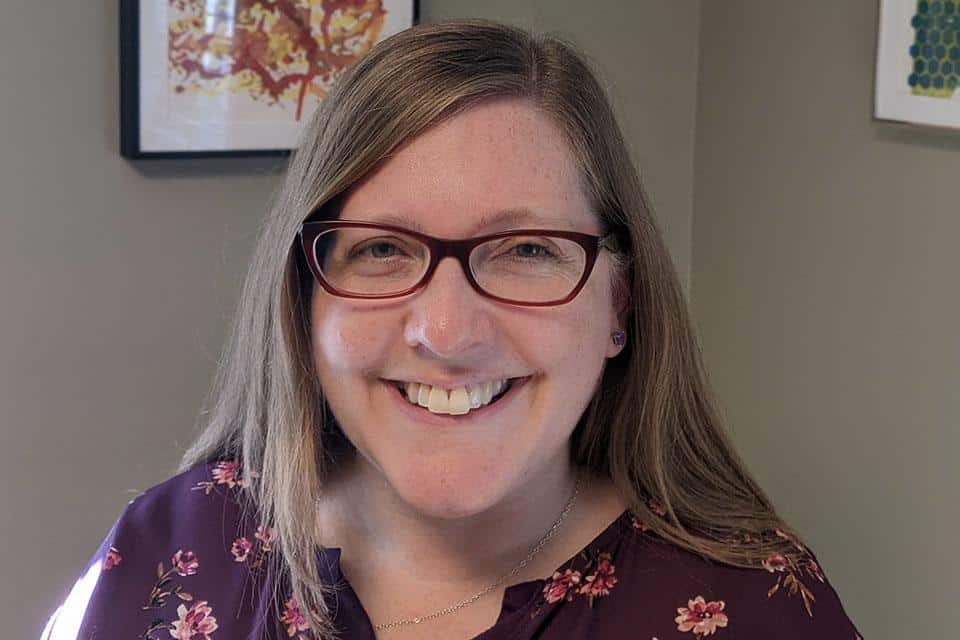This article was originally published by Simmons University. View the full article here.
As a registered art therapist, licensed mental health counselor, and certified dementia practitioner, Meredith Griffiths ’03 is providing the benefits of art-based therapy to the elderly community.
Griffiths is currently overseeing a partnership between the Goddard House, a senior living residence in Brookline, and Opening Minds Through Art (OMA), an evidence-based art making program designed for people with dementia. Gerontologist Dr. Elizabeth “Like’ Lokon started this program in collaboration with the Scripps Gerontology Center at Miami University in Ohio, and OMA has since spread across the country. As Griffiths recounts, Dr. Lokon “brought her background in fine art to her work with older adults and realized that making art is something everyone is able to do throughout the lifespan regardless of cognition.’

Today, anyone can complete the OMA facilitator training program and thereafter begin their own program in any community setting that serves older adults. In an OMA program the artmaking is generally an intergenerational experience, pairing older adults with younger adult volunteers, mostly college students, graduate students, or members of the community. The social aspect of the program’s design can help residents struggling with dementia. As Griffiths says, “with dementia, socialization is one of the best treatments we have. And it is the same with older adults who have been so isolated during the pandemic. It’s a way to foster their social connections again.’
OMA follows a failure-free method of making art. Put differently, OMA emphasizes the process of creating over the end result. Therefore, no one can make something that is “wrong.’ Participants typically create abstract works of visual art, and the facilitator gives them step-by-step instructions that are easy to follow. One specific art making activity is called magic dot. Here participants use watercolors to paint a piece of paper and make circles with a selection of objects (e.g., Q tips or small plastic cups). Participants choose from a compatible color palette and may also enhance their creation with glitter and diverse textures. Griffiths also has participants combine watercolors, leaves, tissue paper, sponges, and metallic paint to create collages that are visually appealing and unique.
In addition to making the art, OMA participants discuss their art with one another. Griffiths helps them articulate their own work using terms and concepts an art critic might use, including balance and composition. Participants may also title their work if they wish.
“Artwork makes them feel good,’ says Griffiths, “it is always about those joyful moments, especially if someone is struggling with dementia or another age-related condition.’ The process of art making also shows older adults that they still have the capacity to create. “Having this sense of agency is important to their wellbeing,’ she says. “This is a failure-free approach, so they can feel like they accomplished something and it boosts their mood. Art stimulates your brain and makes you practice your fine motor skills which you don’t always use as much as you age.’
In recent years, numerous Simmons students have volunteered for OMA. Volunteers are typically paired with the same resident each week to enable regular social interactions. Simmons students socialize with individuals experiencing memory loss, Alzheimer’s, and dementia. Social work major Katelyn Williams ’25 notes that OMA helps elderly adults with their confidence and social skills. “They are now interacting with others,’ says Williams. “They felt a lot more socially connected, and that they had a place to go every week and have this structure.’
Social work student Mya Edith Jara ’24 has found the experience very rewarding. “To me, OMA creates a very non-judgmental space,’ says Jara. “We use a lot of different materials including sponges, cups, ink, and sensory materials to create different artworks. It helps circulate memories and bring back memories. One of the participants I worked with said they loved doing the artwork because it reminded them of being a child, which was special to hear from a person who has dementia.’
Currently, you can view original OMA artworks on the third floor of the School of Management and Academic Building. This exhibition showcases numerous pieces by residents of the Goddard House and other local facilities, and will be on view through mid-January 2023.